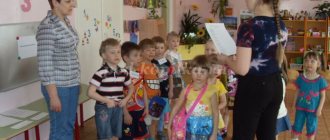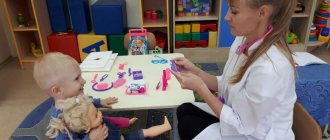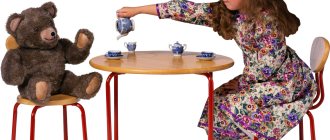MAGAZINE Preschooler.RF
“Designing a role-playing game “Pharmacy”Volokitina Natalya Anatolyevna Educator of the State Budgetary General Educational Institution “School No. 1383” Preschool Department No. 4
Preparatory group
1. Tasks:
- To develop in children the ability to independently develop the plot of the game “Pharmacy” ; promote independent creation and implementation of game plans
- Develop creative imagination, the ability to develop a game together, and continue to develop the ability to negotiate.
- Continue to teach how to perform various roles in accordance with the plot of the game, using attributes, encourage children to independently create items and parts (tools, equipment) that are missing for the game. Cultivate goodwill and willingness to help out a friend.
- To cultivate a sense of responsibility, friendliness, and respect for the profession of pharmacist and pharmacist.
2. Preparing for the game:
4. Progress of the game.
- The day before, the children, together with the teacher, make thermometers, blisters with tablets and capsules, make mustard plasters, recipes, receipts, ointments, and mixtures. As a result of production, interest arises in the beginning of the game.
- Children agree to play the game “Pharmacy” and determine roles. The teacher helps distribute roles, taking into account the wishes of the children. The teacher himself offers children the role of pharmacist, pharmacist, driver, and cleaner in order to increase the children’s activity. The teacher offers himself for the role of pharmacy manager. They discuss the plot. If necessary, the teacher asks clarifying questions:
— Who works in the pharmacy?
— Which child is suitable for the role of a pharmacist?
— Which child is suitable for the role of driver?
- What kind of work do they do?
The teacher helps children determine the most convenient place for play, equip it, lay out the necessary attributes, and select substitute items.
Children play independently:
One by one, clients enter the pharmacy.
- Hello!
— Please, your recipe.
— Sorry, but this drug is not available now. May I suggest you this one?
- Here is your medicine. Please note that it should only be taken after meals.
— Can I offer you some vitamins?
- I don’t like your condition? Are you feeling okay? Should I call an ambulance?
As the game progresses, the teacher reminds you that you need to be polite and courteous with pharmacy clients, talk quietly, because they may not feel well, and tell them in detail how to take the medicine.
3) The teacher participates in the children’s play when a new secondary role is introduced and when the plot of the game becomes more complex.
The teacher, as the head of the pharmacy, monitors the correctness of the game.
4) Techniques for maintaining and developing the plot of the game:
— Introduction of new game situations: Suddenly an unusual suitcase fell from the sky. The children became curious. Let's open it and see what's there? Children list the attributes of medical instruments and drugs (sterile wipes, bandages, syringes, tablets, mixtures, ointments, vitamins and much more) and in the suitcase there is a note with some request.
5) Techniques for forming relationships in the game:
The teacher reminds about relationships, encourages politeness (praise).
5. End of the game
“dialogue” procedure can be repeated 2-3 times. During the game, the teacher encourages the child to consistently change playing roles. At the end of the game, the teacher turns to the children and says that the pharmacy is closing because it is too late, but tomorrow the pharmacy workers will be glad to see you at their place, where you can make purchases. The teacher asks his students whether they liked the game, what new things they learned during the game, and finds out what new game actions they have mastered today.
6. Game evaluation
The teacher thanks the children for the interesting game, asks them if they liked the game, what they remember most. Clarifies why they were interested, correctly notes that each child played in accordance with his role. Invites children to express their opinions by asking each child what he thinks, whether he coped with his role. Separately notes and praises children who find it difficult to make contact. At the end of the game, the teacher asks the children how they can protect their health and what needs to be done for this. Children answer: do exercises, harden up, eat vegetables and fruits, play sports, walk in the fresh air, drink vitamins and take antiviral drugs.
The teacher wishes the children health and distributes delicious, healthy apples to everyone.
| Next > |
Role-playing game "Pharmacy"
Objectives: deepen knowledge about the work of pharmacy workers, help children establish interactions in a joint game, develop the plot
| Roles | Role-playing activities |
| Pharmacist | Takes recipes and orders from customers. gives information about the dosage of a particular medication; packages medications4 dispenses prescription medications |
| Pharmacist | Makes medicine; packs manufactured medications into bags and bottles; signs packaged medications |
| Buyer | Buys medicine, pays; asks for a certificate of use of a particular medicine; shows the recipe, waits while the medicine is being prepared |
| Cashier | Receives money from the buyer and issues a check. |
| Drivers | Brings medicine |
| Head pharmacy | Calls and orders a new batch of medications; issues salaries; supervises the work of employees |
Building role-playing dialogue
| Manager | Buyer | Pharmacist-pharmacist | Chauffeur | Cashier | |
| Pharmacist | Controls the quality of work. Issues salary. | Buys medicine. Asks to explain how to take the medicine. | Do joint work. They communicate. | Delivers medicines | Issues a check, receives money in accordance with the price named by the pharmacist. |
| Pharmacist | Gives instructions for the preparation of medicines. Issues salary | Asks to produce this or that medicine according to a prescription issued by a doctor | Communicate | Delivers components for the manufacture of prescription drugs | |
| Buyer | They communicate. Regulates controversial issues | Takes a turn. They communicate. | Gives medicine and explains how to take it | Receives money, issues a check. | |
| Chauffeur | Issues salary. Sends for new medications | ||||
| Cashier | Supervises the work. Issues salary. | Pays money for medicine | Receives a salary |
Role-playing game "Hospital"
Objectives: to develop interest and respect for the noble profession of medicine. Help children establish interactions in joint play.
| Roles | Role-playing activities |
| Chief physician | Hires medical workers. Organizes work, controls, talks with patients. |
| Medical specialist | Receives the patient, listens, listens, prescribes treatment. Gives advices. Issues sick leave. |
| Nurse | Follows doctor's orders. Talks with patients. Washes tools. |
| Nurse | Cleans the medical office (washes the floor, wipes dust) |
| Registrar | Books patients for appointments. Issues an appointment ticket and a medical card. |
| Patient | Comes to see a doctor with a coupon and honey. card. He tells and shows what hurts. Follows all advice and doctor's prescriptions. |
Project on the topic: “Pharmacy under your feet”
Type of project: educational.
Project duration: short-term.
Project participants: children of the preparatory group (age 6-7 years), group teachers.
Relevance of the topic:
Environmental education is one of the main directions in the education system; it is a way of influencing children’s feelings, their consciousness, views and ideas. Preschoolers feel the need to communicate with nature. They learn to love it, observe, empathize, understand that our Earth cannot exist without plants, since they not only help us breathe, but also treat us from various diseases. We must protect and preserve them, and be able to correctly use their medicinal properties. Environmental education should be considered, first of all, as moral education. When forming a humane relationship with nature, the main thing is for the preschooler to understand that man and nature are interconnected, therefore caring for nature is caring for man and his future. Talking with children on the topic of plants, we saw that children have an insufficient level of knowledge on the topic “Medicinal plants”. While working with parents, we also discovered that many of them have little understanding of the variety of medicinal plants. Therefore, together with the students and their parents, an environmental project “Medicinal Plants” was developed.
Goal: to create conditions for introducing children to the world of medicinal plants, to form ideas about the role of plants in improving and maintaining human health.
Project objectives:
— consolidate children’s knowledge about the medicinal plants of our region, their medicinal properties;
- ability to distinguish medicinal plants by color and appearance;
— introduce children to the rules of collecting and drying medicinal plants.
— activate the vocabulary: peppermint, yarrow, chamomile, plantain.
— to cultivate communication skills, independence, hard work in preschoolers, as well as respect for nature.
Expected Result:
1. Expanding children's knowledge and understanding of medicinal plants.
2. Rules for collecting and drying medicinal plants.
3. The emergence of interest among parents in the life of a preschool educational institution.
Project implementation stages
Stage 1: preparatory - planning, collecting medicinal plants.
Stage 2: organizational – creating a developmental environment, developing the content of direct educational activities, making a herbarium from plants collected by children.
Stage 3: formative – holding events with children and parents.
Stage 4: final – analysis of the results obtained.
Implementation activities:
Forms of working with children:
Looking at illustrations and paintings of medicinal plants, learning poems and riddles about plants.
Goal: To develop children's cognitive interest in the life of medicinal plants, to develop children's speech, to enrich their vocabulary.
Conversation: “The importance of medicinal plants in human life” Goal: To expand and develop children’s knowledge about medicinal plants, their value for human health.
Reading poems: “Flowers” by A. A. Senkov, “Raspberry” by N. Astakhov, etc.
Learning songs and poems about medicinal plants.
Manual labor:
- modeling: “Miracle - plants” Purpose: to stimulate the child’s imagination and imagination.
— drawing: “Our friend is the plantain” Purpose: to develop children’s creative abilities in drawing plantains.
Coloring pages for children on the theme of plants.
Didactic games “What does this plant heal?”, “Find out by description.”
Mobile folder for parents: “Medicinal plants are under our feet.”
Project outcome
Making a presentation on the topic “Pharmacy under your feet.”
Effectiveness of the project: consciously correct attitude of children towards plants that help human health; expand ideas about nature, develop cognitive interest, develop knowledge about medicinal plants, enrich children’s experience in the field of environmental education.
Project implementation scheme.
| Educational area | Forms of work |
| Communication Cognition | Consideration of medicinal plants. Conversation “What are plants for?” GCD "Pharmacy under your feet" Goal: generalize children's knowledge about medicinal plants. Excursion. |
| Socialization | Didactic games “What does this plant heal?”, “Find out by description.” |
| Artistic creativity | Coloring pages for children about plants. Drawing “Our friend plantain” Modeling “Miracle Plants”. |
| Work | Making a herbarium with children. |
| Fiction | Reading. “Flowers” by A. A. Senkov, “Raspberries” by N. Astakhov, etc. |
Progress of the game:
Voss: Children, guess the riddle:
If you have a cough or flu,
Or your voice is hoarse
If a person feels bad -
We're in a hurry. (to pharmacy )
Right.
Remember when we went to the pharmacy ? (Yes)
Why do you need a pharmacy ? (To sell/buy medicines)
Listen and guess another riddle:
There are hardly any on the shelves
Not marshmallows, not chocolate,
Not cookies, not candy,
And different. (PILLS)
What, besides medicines and pills, can you buy at the pharmacy ? (Vitamins, bandages, thermometers, etc.)
What departments are there in the pharmacy ? (prescription, non-prescription drug sales department, medicinal herbs department, medical equipment department, baby products department)
Who works in the pharmacy ? (Manager, pharmacist , driver for delivery of medicines, etc.)
Children's answers:
Do you know what everyone who works in a pharmacy ?
We talk and discuss with the children what duties this or that worker performs and what tools are needed.
Would you like to set up a pharmacy in our group ?
Children: Yes, very much.
Manager (pharmacist)
- Manages the work
of the pharmacy , orders goods, answers customer calls (computer, telephone)
Pharmacist - lays out goods, advises, offers, shows, sells
Taxi driver - Receives goods, sorts them,
Supplier - accepts orders, delivers goods, unloads
Buyer - asks politely, chooses, buys
An ophthalmologist examines and competently prescribes treatment.
Construction of role-playing dialogue.
After preparing the place and selecting the attributes, I invite the children to act out game dialogues, come up with a plot for the game on their own, and play them with other children.
The guys assigned roles: Manager, pharmacist, taxi driver, supplier, buyer, ophthalmologist, I will be the buyer and three more children and started the game.


